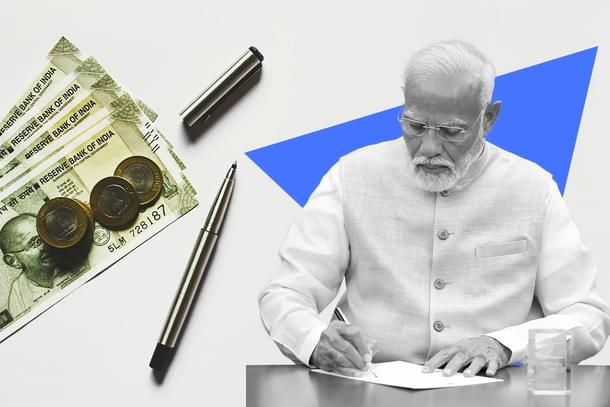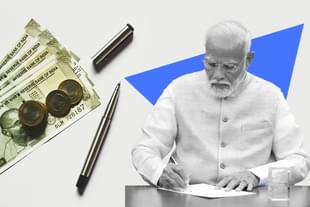Economy
Unified Pension Scheme: Modi Takes A Bitter Tablet To Avoid The Black Pill?
Arush Tandon
Aug 26, 2024, 10:29 AM | Updated Aug 30, 2024, 03:50 PM IST
Save & read from anywhere!
Bookmark stories for easy access on any device or the Swarajya app.


The Unified Pension Scheme received the Union Cabinet approval on 24 August, and soon enough, social media was filled with chatter of how this was yet another instance of Modi capitulating before the Congress.
‘Reforms are dead’. ‘It’s over’. Those frustrated with the UPS announcement chose to voice their anger in such and other harsher posts.
The thrust of these arguments was that the National Pension System (NPS) was the ideal pension programme and the introduction of an alternative scheme was as bad as going back to the Old Pension Scheme (OPS).
Before going further into this debate, here is a brief look at the UPS and how it actually compares with the OPS.
The UPS scheme consists of three main parts:
1. A 50 per cent assured pension
2. An assured family pension
3. An assured minimum pension
Assured pension
Will be calculated as 50 per cent of the average basic pay from the 12 months preceding retirement. Employees with at least 25 years of service will be eligible for this pension.
Assured family pension
If an employee passes away, 60 per cent of the pension they were receiving prior to their death will be provided to their family.
Assured minimum pension
This will guarantee a monthly payment of Rs 10,000 for employees retiring after at least 10 years of service.
UPS, NPS, and OPS
The UPS, like the NPS, is a contributory scheme. Like the NPS, the employees would contribute 10 per cent of their salaries to the pension fund under UPS too.
However, while the contribution of employees has stayed the same, the share of the government has gone up. The government would now contribute an amount equivalent to 18.5 per cent of the employee’s pay to the pension fund under the UPS. In the NPS, this number was 14 per cent. (When the scheme was introduced the number was 10 per cent. It was increased to 14 under Modi).
This is fundamentally different from the OPS, where the entire pension burden is borne by the government with no contribution from the employees.
One expected question at this juncture is that doesn’t the UPS also put a burden on the government’s funds then? How will the assured 50 per cent amount be given?
Under the NPS, the monthly payouts are based on market returns. In theory, they could be lower or higher than 50 per cent of the employee’s last drawn salary.
In the UPS, the government is assuring 50 per cent of the average of the employee’s base pay in the last 12 months of their service. Who funds this assurance? And who funds the gap between the corpus payout and the assurance? Also, how much will that gap be?
One report stated that the government would incur an additional Rs 6,250 crore in the first year of the UPS. Most of it is likely to go towards funding the gap mentioned above.
Another answer is found in this tweet by a financial journalist with Reuters, Ira Dugal. ‘The 50% assured pension may or may not need govt to fill the gap. Some experts had explained to me that the current calculus in many cases was anyway working out to 40-50% pension benefits.” In other words, the pension corpus formed through the NPS was anyway paying out 40-50 per cent of the retired employees’ salaries per month.
So if the initial reports suggest that the UPS will be within fiscally manageable limits, what is driving the outrage against it among a section that is largely sympathetic to Modi?
It is the fact that the announcement is seen as a sign of bending down before the Congress and workers unions.
The Congress party, over the last two years, has made OPS one of its main campaign planks and Congress/INDI governments even reverted to the OPS in states like Chhattisgarh, Rajasthan, Jharkhand, Karnataka.
The charge on Modi is that the results of the Lok Sabha elections have stupefied him and the UPS is just another example of it.
The first counter to this charge is that UPS was not introduced arbitrarily or even as a reflex response after 4 June. This has been in the works since April 2023 when the TV Somanathan Committee was formed to look into the demands of government employees to review NPS.
The UPS is a result of the deliberations of the Committee. Somanathan was then serving as the Finance Secretary and is currently the Cabinet Secretary designate.
The other argument to be made in defence of the UPS is that if government employees are agitating for some proportion of their pension to be assured, a government cannot turn down that demand without looking stubborn at best and pitiless at worst. The UPS is a political measure implemented through the fiscal route.
The third argument in defence of the UPS can be that it creates a manageable burden but eliminates the worst-case scenario where state and central government employees force a wholesale return to OPS.
Ashwini Vaishnaw stating that state governments can adopt the same framework for UPS at the state level too is as much a nudge to chief ministers as it is a gentle veer away from the road that leads to OPS. And with the assured payment component, government employees might discover that the yearning for OPS is not that strong anymore.
In sum, political parties and state governments now have reasons to think that it’s not worth going back to the OPS now.
There are few caveats here though:
1. At the time of writing, there was no conclusive proof either way of how the government employees have in fact reacted to the UPS announcement.
2. As pointed out by observant handles on social media, the viability of the UPS depends to a large extent on what the 8th Pay Commission does.
3. Other unknowns include the average period for which a government has to pay the pension. With better health outcomes, this period is only increasing. Related to this is the retirement age. Will it remain the same or will a future government change it?
4. Will there be demands to increase the proportion of the assured pension from 50 to higher?
For now though, it appears like Modi sees the OPS as a worst-case scenario event, and his government is willing to undergo some discomfort if it helps to eliminate the worst-case scenario altogether.
Arush Tandon is interested in icons of history, history of independent India and, Indian culture.





